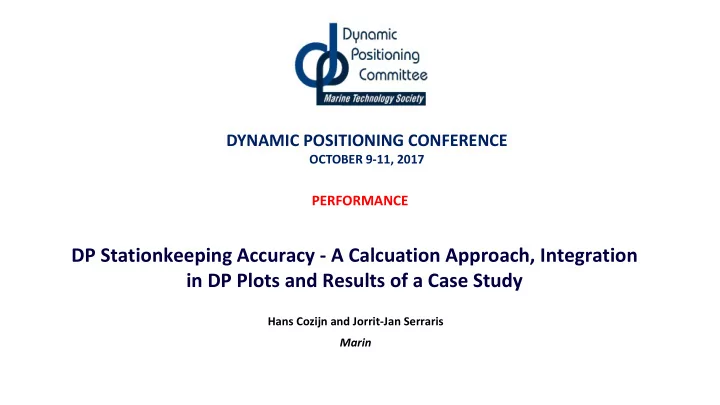

DYNAMIC POSITIONING CONFERENCE OCTOBER 9‐11, 2017 PERFORMANCE DP Stationkeeping Accuracy - A Calcuation Approach, Integration in DP Plots and Results of a Case Study Hans Cozijn and Jorrit-Jan Serraris Marin
DP STATIONKEEPING ACCURACY A CALCULATION APPROACH, INTEGRATION IN DP PLOTS AND RESULTS OF A CASE STUDY Hans Cozijn and Jorrit-Jan Serraris
PRESENTATION OUTLINE • Study Objective • Available Analysis Methods • Proposed Calculation Approach • Concluding Remarks 2
STUDY OBJECTIVE Propose a calculation method that combines the advantages of time-domain simulations and static DP capability calculations. • Results give an immediate impression of the vessel DP capability in a single diagram • Results include information on stationkeeping accuracy and other operational parameters. 3
PRESENTATION OUTLINE • Background • Available Analysis Methods • Proposed Calculation Approach • Concluding Remarks 4
DP STATIONKEEPING ANALYSIS METHODS • Static Calculations + Simple and fast + Easy to compare thruster types, • Time-domain Simulations sizes and positions • DP Model Tests + Easy to analyze effects • Sea Trials of thruster failure - Mean loads only - No stationkeeping accuracy - Difficult to compare calculations from different sources 5
DP STATIONKEEPING ANALYSIS METHODS • Static Calculations + Complete simulation model of DP vessel in wind, waves, current • Time-domain Simulations + Dynamic effects are included • DP Model Tests + Determine stationkeeping accuracy • Sea Trials + Optimize filter and control settings + Investigate transient response - More input data required - Need to run many simulation cases - Run sufficiently long simulations - Post-processing of results 6
DP STATIONKEEPING ANALYSIS METHODS • Static Calculations + Complete representation of DP vessel in wind, waves, current • Time-domain Simulations + All physics are included • DP Model Tests (possible un-expected behavior) • Sea Trials + Safely investigate limiting cases + Optimize filter and control settings + Generic or commercial DP system - Costs - Risk of scale effects 7
DP STATIONKEEPING ANALYSIS METHODS • Static Calculations + "The Real Thing" + No simplifications or assumptions • Time-domain Simulations • DP Model Tests • Sea Trials - Costs - Vessel availability - No control over environment - Too late for design changes Photo : Havyard Design & Solutions AS 8
PRESENTATION OUTLINE • Background • Available Analysis Methods • Proposed Calculation Approach • Concluding Remarks 9
PROPOSED CALCULATION METHOD • Time-domain Simulation Model • Execute Simulations • Current; variation V c , direction • Waves; variation H s , T p , direction (IMCA) • Wind; linked to waves (IMCA, ERN) • Swell; variation H s , T p , direction • Several 1,000 individual simulations • Store Results in Database • Apply Operational Criteria 10
STEP-BY-STEP APPROACH • Time-domain simulation model • Execute simulations • Store results in data base • Apply operational criteria 11
STEP-BY-STEP APPROACH • Time-domain simulation model • Execute simulations • Store results in data base • Apply operational criteria "CONDOR" batch simulations 250+ desktop PCs (in network) 20,000 or more cases +/- 1 night, or 1 weekend 12
STEP-BY-STEP APPROACH • Time-domain simulation model • Execute simulations • Store results in database • Apply operational criteria 13
STEP-BY-STEP APPROACH • Time-domain simulation model • Execute simulations • Store results in data base • Apply operational criteria 14
EXAMPLE - ACCESS SYSTEM MOTIONS Gangway Stroke 5 m Gangway Stroke 7 m Gangway Stroke 9 m Motions Exceeding Criteria; Gangway placed Midship and at Stern 15
ADVANTAGES AND LIMITATIONS • Advantages • Evaluation of stationkeeping capacity and accuracy , as well as other operational criteria (motions, accelerations) • Presentation of results in familiar polar plots • Set of operational criteria can be up-dated, without the need to re-calculate • Limitations • More detailed input data required, compared to static calculations • Computational effort 16
PRESENTATION OUTLINE • Background • Available Analysis Methods • Proposed Calculation Approach • Concluding Remarks 17
SUMMARY REMARKS • Different Methods Exist to Evaluate DP Capability • Static • Time-domain • Model tests • Sea trials • Time-domain Simulation Based Calculation Method is Proposed • Presentation of results similar to static calculations • Benefits of a time-domain simulation approach • Evaluation of multiple operational criteria 18
THANK YOU ! Hans Cozijn Senior Project Manager Offshore
Recommend
More recommend